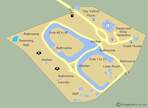
Shingwedzi Rest Camp in Kruger National Park is situated in prime elephant and buffalo country where large herds can be found.
In the midst of a peaceful clearing along the Shingwedzi River, set within two adjacent rings are the camp's accommodation bungalows and its luxury guesthouse. Guests can choose to stay in the rustic huts or comfortable air-conditioned bungalows. A 4-bed cottage is also available for guests to use.
Getting There

Where is Shingwedzi Rest Camp?
Shingwedzi Rest Camp is located in the Northern part of the Kruger National Park.
What is the closest Kruger Park entry gate to Shingwedzi Rest Camp?
Punda Maria Gate is just 71 km away from Shingwedzi Rest Camp.
What is the closest airport to Shingwedzi Rest Camp?
The closest airport is Phalaborwa Kruger Park Gateway Airport, 140km away from Shingwedzi Rest Camp
How long does it take to drive to Shingwedzi Rest Camp from Johannesburg?
It takes 7.20 hours to drive from Johannesbrg to Shingwedzi Rest Camp.
What is the GPS coordinates of Shingwedzi Rest Camp?
-23.113570 S 31.433140 E
Facilities

Get in touch with nature, track wildlife and birds on foot or head off on game safari drives in search of Lion and Leopard.
Or why not set off on an unforgettable, heart-racing game walk out in the bush surrounding Shingwedzi Rest Camp, or take a mystical night drive out in the African wilds.
Along the way, break for a barbeque and let the whoop of the Hyena and the frog-like call of the Mozambique nightjar enchant you.
The 21 kilometres (13 miles) sycamore-lined route which passes by the Kanniedood Dam is a perfect place to be on the lookout for Crocodile, Hippopotamus, Elephant, Bushbuck, and even Leopard.
The region around the Shingwedzi River is scattered with many mopane trees and many animals are reliant on this tree.
What facilities does Shingwedzi Rest Camp have?
- Information at Reception
- Cafeteria
- Shop
- Restaurant
- Cutlery and Crockery Hamper
- Mini ATM facility available in the restaurant
- Petrol Station
- Laundromat
- Picnic Facilities
- Swimming Pool
- Communal kitchens
- Communal bathrooms
- Public Telephone
- Post Box
- Basic First Aid Assistance
- DSTV only Available in Guest Houses
- Cellphone reception
Accommodation

Where can I stay at Shingwedzi Rest Camp?
There is accommodation catering for all vacation budgets, including the luxurious and spacious Rentmeester Guesthouse, offering a comfortable stay overlooking the Shingwedzi River.
The Shingwedzi River flows only in the summer months, but winter is one of the best times to view wildlife when animals fight over the small diminishing pools which remain behind as the river recedes.
Shingwedzi Rest Camp offers guests a variety of accommodations in Kruger National Park. Sleep under the African sky in your tent or caravan.
There are 50 sites with power points and rotating braai (barbeque) grids available.
Communal ablutions and cooking facilities are also available. The cooking facilities include 24 hour boiling water, washing up facilities, and electric hotplates. A maximum of 6 guests per site is allowed.
Accommodation Types
- Campsites
- Huts
- Bungalows
- Cottage
- Guest House
See more Shingwedzi Rest Camp accommodation
Dining

Where can I eat at Shingwedzi Rest Camp?
At Shingwedzi Restaurant, guests can enjoy tasty meals and thirst-quenching drinks. Ideal for quick bite to eat or a lengthy 3-course meal.
Hippo's can often be seen frolicking in the pools below the restaurant. Traditional local music plays softly in the background.
Eager waiters and waitresses welcome you in while the ambiance beckons you in and the tantalizing smell of well-prepared cuisine is enough to mistake this for paradise.
Wildlife

What wildlife can I see around Shingwedzi Rest Camp?
During this South Africa safari you will see that Elephant, Baboon and Vervet Monkey. These animals are all prominent, as are tree squirrels, especially in the camp itself.
Predators include Lion, Leopard and Spotted Hyena and there are a couple of packs of Wild Dog that roam these northern reaches of the Kruger National Park.
There are open plains north of Babalala Picnic Site where Cheetah are regularly recorded. This is a good place to search for the rare large Antelope species: Roan, Sable, Tsessebe, Eland and Lichtenstein's Hartebeest.
See more on Shingwedzi Rest Camp activities
History of Shingwedzi Rest Camp
Associated first and foremost with Elephant, the world's largest land mammal. Breeding herds of 50 to 60 animals are common in this region. During the 1970s and 1980s some of the Kruger National Park's biggest tuskers roamed the region.
These elephants were named the Magnificent Seven, and one, Shingwedzi who died near the rest camp in 1981, carried tusks which weighed in at 47 and 58 Kg respectively. His tusks, as well as those of his fellow giants, can be viewed at Letaba Rest Camp.
It still remains uncertain from where the name Shingwedzi is derived, but it is believed that the early Tsonga named the rivers of this area after prominent local people. Shingwedzi is said to be a combination of Shing-xa-goli, the name of a prominent person and 'njwetse', which describes the sound of iron being rubbed together.


